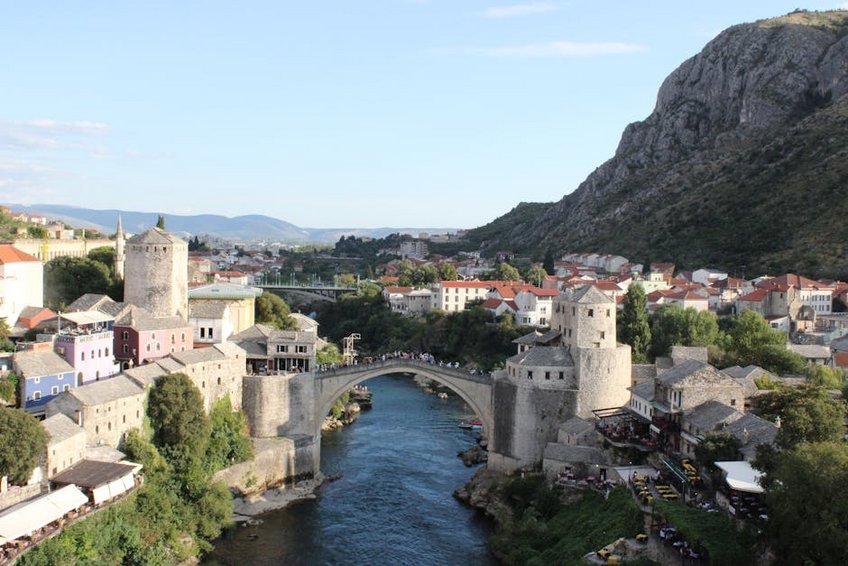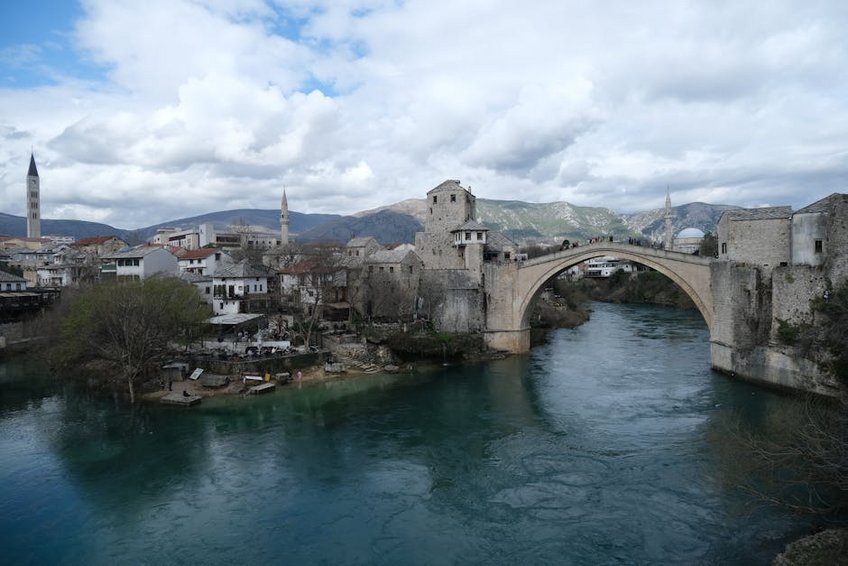Mostar Bridge: The Ultimate Travel Guide to Bosnia’s Iconic Landmark
Standing proudly over the emerald-green Neretva River, Mostar Bridge represents one of Europe’s most breathtaking architectural marvels and symbolic landmarks. This magnificent 16th-century Ottoman bridge connects not just two parts of a city but also cultures, histories, and people from around the world. Visiting Mostar Bridge offers you an unforgettable journey through time, where every stone tells stories of resilience, beauty, and cultural fusion. As you walk across its smooth, weathered stones, you’ll feel the weight of history beneath your feet while witnessing the incredible diving tradition that has made this bridge famous worldwide. The surrounding Old Bazaar area transports you to another era with its cobblestone streets, traditional crafts, and the scent of Bosnian coffee filling the air. Whether you’re a history enthusiast, architecture lover, or simply seeking authentic travel experiences, Mostar Bridge delivers an emotional and visual spectacle that will stay with you long after your visit.
Mostar Bridge Essential Information – History and Significance
Constructed in 1566 during the Ottoman Empire under the guidance of architect Mimar Hayruddin, Mostar Bridge represents a masterpiece of Islamic architecture in the Balkans. The bridge’s elegant single-arch design spans 28 meters in length and stands 24 meters above the river, creating a breathtaking silhouette against the Bosnian sky. What makes this structure particularly remarkable is its construction technique using local tenelija stone and special mortar made from egg whites, which contributed to its legendary strength and durability. For centuries, the bridge served as a vital trade route connecting the Adriatic coast with the interior of the Balkans, earning the city its name “Mostar” which means “bridge keeper.” The structure survived natural disasters and centuries of use until its tragic destruction during the Balkan conflicts in 1993, an event that shocked the international community. Following the war, an extensive reconstruction project began using original techniques and materials, culminating in the bridge’s reopening in 2004 as a UNESCO World Heritage Site. Today, it stands not just as a beautiful monument but as a powerful symbol of reconciliation and cultural coexistence.
Architectural Marvel – What Makes It Special
- The bridge’s single hump-backed arch was an engineering marvel of its time, using precisely cut stones without any reinforcement materials
- Traditional construction methods included using local tenelija stone and special mortar containing egg whites, horsehair, and ash
- Its design withstands temperature variations from -20°C to +40°C (-4°F to 104°F) and the powerful Neretva River currents below
- Budget travelers can manage with $40-50 daily staying in hostels, eating at local bakeries and ćevapi stands, and walking everywhere
- Mid-range visitors should budget $80-120 daily for comfortable hotels, restaurant meals, museum entries, and occasional taxis
- Luxury experiences including boutique hotels, fine dining, private guides, and day trips range from $150-250+ per day
- UNESCO World Heritage Centre
- Bosnia and Herzegovina Tourism Board
Cultural Symbolism – Beyond Architecture
Mostar Bridge transcends its physical presence to embody deep cultural and symbolic meanings for both locals and visitors. For the people of Mostar, the bridge represents their city’s soul and a connection between the predominantly Muslim east bank and Christian west bank. The structure’s destruction during the Balkan War symbolized the breakdown of intercultural dialogue, while its meticulous reconstruction became a powerful message of hope and reconciliation. UNESCO’s involvement in the rebuilding process highlighted the bridge’s importance as cultural heritage belonging to all humanity rather than any single group. Today, watching divers leap from the bridge’s highest point continues an ancient tradition that speaks to human courage and the enduring spirit of the city. The bridge has become a meeting point where tourists from around the world gather to witness this spectacle, share stories, and appreciate the resilience of human creativity and cooperation.

Mostar Bridge Planning Your Trip – Best Times and Budget
Planning your visit to Mostar Bridge requires consideration of seasonal weather patterns, crowd levels, and local events that might enhance your experience. The bridge and surrounding Old Town area can be comfortably explored in one full day, though many travelers choose to spend 2-3 days to fully immerse themselves in Mostar’s unique atmosphere and also visit nearby attractions like Kravice Waterfalls or Blagaj Tekke. Spring (April-June) and autumn (September-October) offer the most pleasant conditions with mild temperatures between 15-25°C (59-77°F) and smaller crowds compared to the peak summer months. Summer brings hotter weather often exceeding 30°C (86°F) but also the highest chance of witnessing the famous bridge divers in action. Winter visits provide a completely different atmosphere with possible snow dusting the ancient stones, though some facilities may have reduced hours. Regardless of when you visit, wearing comfortable walking shoes is essential as the bridge’s smooth stones and Old Town’s cobblestone streets can be challenging in inappropriate footwear.
Best Time to Visit Mostar Bridge
The ideal time to visit Mostar Bridge depends largely on your preferences for weather, crowds, and cultural experiences. Late spring (May-June) offers perfect conditions with comfortable temperatures around 20-25°C (68-77°F), blooming flowers throughout the city, and manageable tourist numbers before the summer rush. Early autumn (September-October) provides similar advantages with the added beauty of fall colors reflecting in the Neretva River. Summer months (July-August) guarantee the warmest weather and highest probability of seeing traditional bridge diving, but you’ll need to contend with larger crowds and higher accommodation prices. Winter visitors (December-February) will experience a more intimate atmosphere with fewer tourists, though some restaurants and shops may have reduced hours, and the bridge can be slippery when wet or icy. For photography enthusiasts, the golden hours around sunrise and sunset provide the most dramatic lighting on the bridge’s pale stone against the emerald river.
Budget Planning and Costs
Essential Preparation Checklist
Preparing for your Mostar Bridge visit involves both practical considerations and cultural awareness to ensure a respectful and enjoyable experience. Ensure your passport has at least six months validity if traveling from outside Europe, though most Western passport holders don’t need a visa for Bosnia and Herzegovina for stays up to 90 days. The local currency is the Convertible Mark (BAM), though euros are widely accepted in tourist areas—carry some cash as smaller establishments may not accept credit cards. Pack comfortable walking shoes with good grip for the bridge’s smooth stones and Old Town’s cobblestone streets, plus modest clothing if planning to visit religious sites. Learn a few basic phrases in Bosnian like “hvala” (thank you) and “dobar dan” (good day), which locals appreciate greatly. Finally, bring a camera with extra memory cards—you’ll want to capture the bridge from every angle, especially during golden hour when the light creates magical reflections on the water.
Mostar Bridge Top Attractions and Activities – Beyond the Bridge
While the iconic bridge rightfully claims center stage, the surrounding area offers numerous attractions that enrich your Mostar experience. The Stari Most (Old Bridge) area itself contains several significant sites including the Tara and Halebija towers that once guarded the bridge, now housing exhibits about its history and reconstruction. The Old Bazaar (Kujundziluk) spreads out from the bridge’s approaches with its charming cobblestone streets lined with copper workshops, carpet sellers, and traditional artisans practicing crafts passed down through generations. Don’t miss the Koski Mehmed Pasha Mosque with its stunning interior and minaret offering the best panoramic views of the bridge and city—worth the climb for photography enthusiasts. Just a short walk away, the Museum of War and Genocide provides sobering but important context about the region’s recent history, while the nearby Muslibegović House showcases exquisite Ottoman architecture and lifestyle. For a different perspective, consider taking a river rafting trip on the Neretva or visiting the picturesque nearby towns of Blagaj and Počitelj.
Must-See Highlights
Your Mostar Bridge visit should include these essential experiences to fully appreciate the site’s cultural and historical significance. First, walk across the bridge slowly, noticing how the smooth stones underfoot have been worn by centuries of footsteps—try to visit at different times of day to see how the light changes its appearance. Climb the minaret of Koski Mehmed Pasha Mosque for breathtaking panoramic views of the bridge arching over the emerald waters, especially spectacular during sunrise or sunset. Watch for the famous bridge divers—members of the Mostar Diving Club who continue the centuries-old tradition of leaping from the highest point into the river below (they usually collect tips from spectators first). Explore the Old Bazaar area to admire traditional copperwork, purchase handmade souvenirs, and sample local specialties like baklava and strong Bosnian coffee. Finally, visit both sides of the bridge to appreciate how it connects different communities, and don’t miss the “Don’t Forget” stone engraved with 1993—the year of the bridge’s destruction—as a poignant reminder of its history.
Hidden Gems and Local Favorites
Beyond the main tourist trail, Mostar offers several lesser-known experiences that provide deeper insight into local life and history. Tepa Market, located just outside the Old Town, offers an authentic glimpse into daily life where locals shop for fresh produce, cheeses, and other goods—perfect for food enthusiasts and photographers. The abandoned Zrinjevac swimming pool complex, though melancholic, provides fascinating urban exploration opportunities and unusual views of the bridge from a different perspective. For a unique dining experience, seek out Sadrvan restaurant’s garden terrace or enjoy traditional music performances at Ali Baba restaurant. The nearby Bijeli Mosque, though smaller than others, offers a peaceful atmosphere and beautiful courtyard away from the crowds. During summer evenings, join locals strolling along the Neretva riverbanks or enjoying drinks at one of the many cafes with bridge views—these simple moments often become the most memorable parts of any visit to Mostar.
Mostar Bridge Practical Travel Information – Getting There and Staying
Reaching Mostar Bridge requires some planning as the city isn’t directly connected to major international transportation hubs, but the journey itself becomes part of the adventure. Most international travelers fly into Dubrovnik (Croatia), Sarajevo, or Split airports, then continue by bus or rental car—the scenic drive from Dubrovnik takes approximately 2.5 hours through beautiful coastal and mountain landscapes. Once in Mostar, the bridge and Old Town area are completely walkable, with no need for transportation unless visiting outlying attractions. Accommodation options range from budget hostels to charming guesthouses and luxury hotels, with the most atmospheric stays found in converted traditional houses within the Old Town. For dining, you’ll find excellent Bosnian cuisine at various price points, from casual ćevapi stands to fine restaurants with bridge views. Remember that Bosnia uses Type C and F electrical outlets (220V), and while English is widely spoken in tourist areas, learning a few Bosnian phrases will enhance your interactions with locals.
| Category | Options/Features | Price Range (USD) |
|---|---|---|
| Budget Accommodation | Hostels, guesthouses in Old Town | $20-40/night |
| Mid-range Hotels | 3-4 star hotels with breakfast | $60-100/night |
| Luxury Stays | Boutique hotels, river views | $120-200/night |
| Local Meals | Ćevapi, burek, bakeries | $5-10/meal |
| Restaurant Dining | Traditional Bosnian cuisine | $15-25/meal |
| Attraction Entries | Museums, mosque entries | $3-8/entry |


